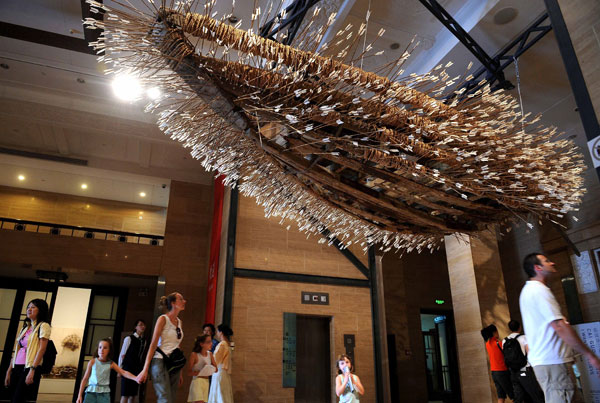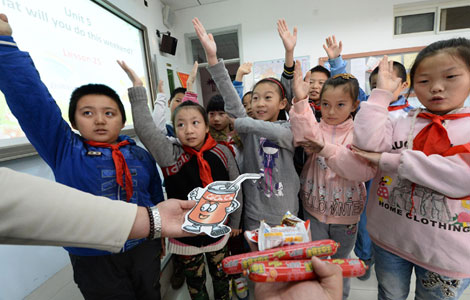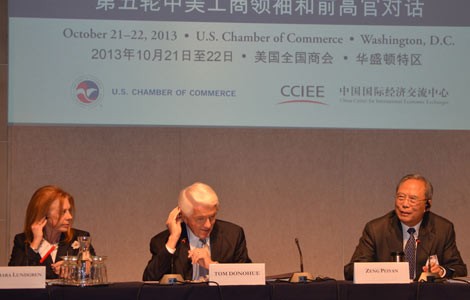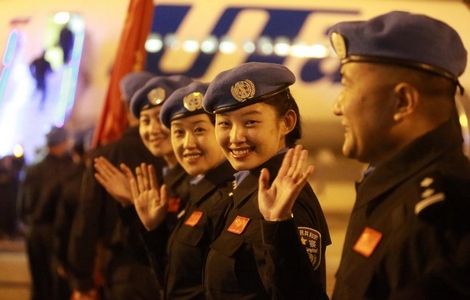Paint the world a picture
Updated: 2013-10-25 01:58
By Xu Jingxi (China Daily)
|
||||||||
|
 |
|
Cai Guoqiang's installation Borrowing Your Enemy's Arrows has been widely seen in the West. Jiang Hongjing / Xinhua |
"The art museums in China should keep improving themselves to become world-class. Artists will be confident to display their works in local museums if they can gain attention and influence that is equal to if they put on an exhibition in a Western museum," Lee says.
To share their experience of managing art museums and promoting Asian art, 82 directors and senior curators of museums from 30 countries and regions across Asia, Europe and the Americas gathered in Guangzhou, Guangdong province, in September, to take part in the first Asian Art Curators' Forum, co-organized by Guangdong Museum of Art and National Art Museum of China.
Participants came to a consensus that Asian art museums will share their online resources and jointly put on biennials to display their collections.
For Western guests like Levenson from the MoMA and Lee from the Tate, the forum offered a great opportunity to learn about Asian art and seek international cooperation.
"Chinese art should proactively venture out to promote itself overseas. For example, many art galleries in Latin America travel around the world to art fairs to display their local artworks," Levenson says.
Chinese artists could learn from the experience of some Asian countries.
The National Museum of Modern and Contemporary Art in South Korea has taken its touring exhibitions of Korean art across Asia, to North America, Europe and other regions.
The National Museum of the Philippines is planning to engage people living in the Filipino community in Chicago to host an exhibition on Philippine traditional art.
Jason Sun, a curator from the Department of Asian Art of the New York-based Metropolitan Museum of Art, hopes Chinese art museums can be more open-minded to collect Western artworks and enhance their cooperation with Western art museums.
"The communication between the Metropolitan and Chinese art museums over the past 30 years has been one-way: Metropolitan borrows relics from Chinese art museums to display to Western audiences," Sun says.
The exhibition of the Metropolitan's select collection at the National Museum of China in Beijing from February to May was the American museum's first loan exhibition to China.
"It used to be high risk to lend our collections to Chinese art museums because their hardware, such as humidity and temperature-controlling equipment, was not good enough," Sun says.
"But many newly built or renovated Chinese museums have world-class equipment thanks to the country's rapid economic growth in the past decade. What they lack now is an open mind and curators with in-depth knowledge of Western arts."
He advises Chinese art museums to be all-embracing like their peers in Japan.
The National Museum of Western Art in Tokyo was established specially for introducing Western art to Japanese people. Tokyo National Museum's collection of Chinese relics is even better than those of some Chinese art museums.
"For contemporary art, a global vision and an open mind are especially important," Sun adds.
"Many Chinese contemporary artists I've met in the US don't like being called a Chinese artist. They introduce themselves as a contemporary artist.
"They are not denying their roots in China. In their eyes, contemporary art is beyond national boundaries."
Contact the writer at xujingxi@chinadaily.com.cn.

 Post-baby Duchess
Post-baby Duchess
 Victoria Beckham S/S 2014 presented during NYFW
Victoria Beckham S/S 2014 presented during NYFW
 'Despicable' minions upset Depp's 'Lone Ranger' at box office
'Despicable' minions upset Depp's 'Lone Ranger' at box office
 'Taken 2' grabs movie box office crown
'Taken 2' grabs movie box office crown
 Rihanna's 'Diamonds' tops UK pop chart
Rihanna's 'Diamonds' tops UK pop chart
 Fans get look at vintage Rolling Stones
Fans get look at vintage Rolling Stones
 Celebrities attend Power of Women event
Celebrities attend Power of Women event
 Ang Lee breaks 'every rule' to make unlikely new Life of Pi film
Ang Lee breaks 'every rule' to make unlikely new Life of Pi film
Most Viewed
Editor's Picks

|

|

|

|

|

|
Today's Top News
Vice-premier calls for strengthened EU ties
Spy claims stir rebuke to Obama
Traders in Yiwu cashing in on e-commerce shops
PMI heads for 7-month high
Ministry to begin inspecting most heavily polluted regions
Ban to help protect kids from sexual predators
Returnees are 'seed capital' for startups
US firms urge easier process for investment
US Weekly

|

|







